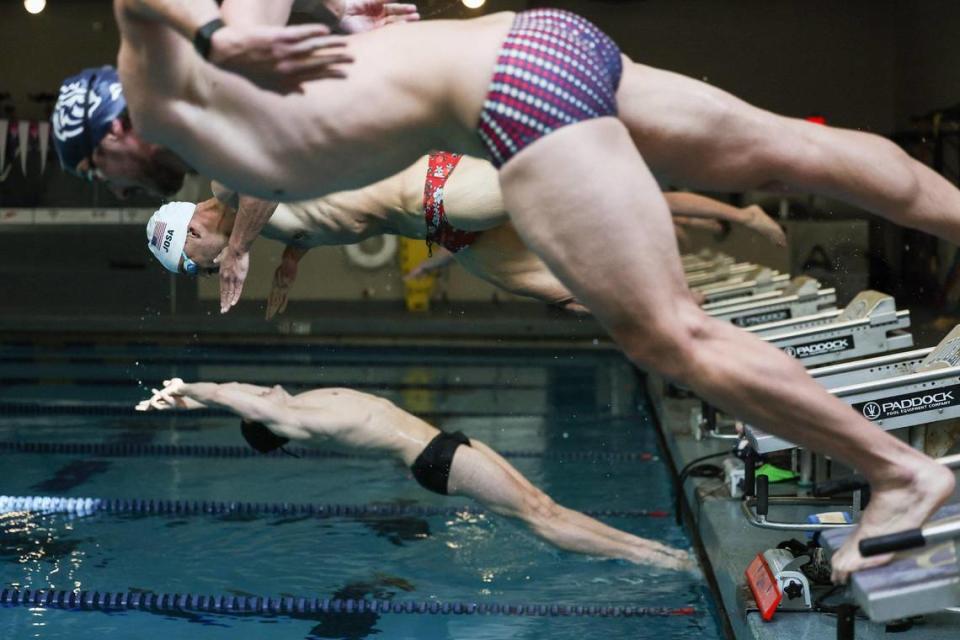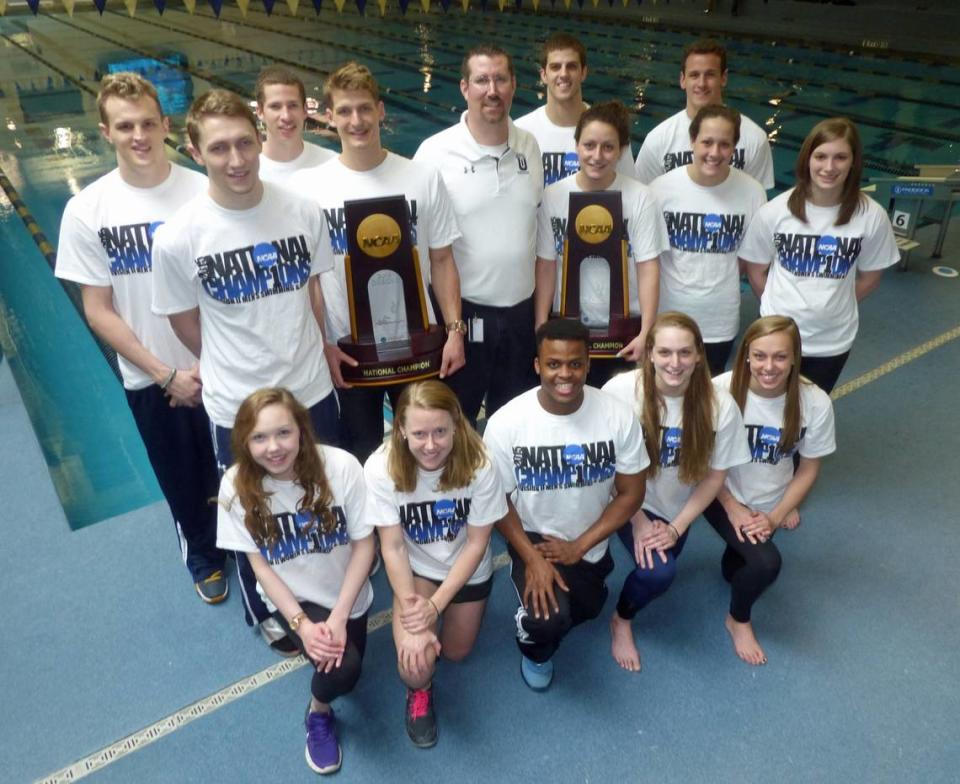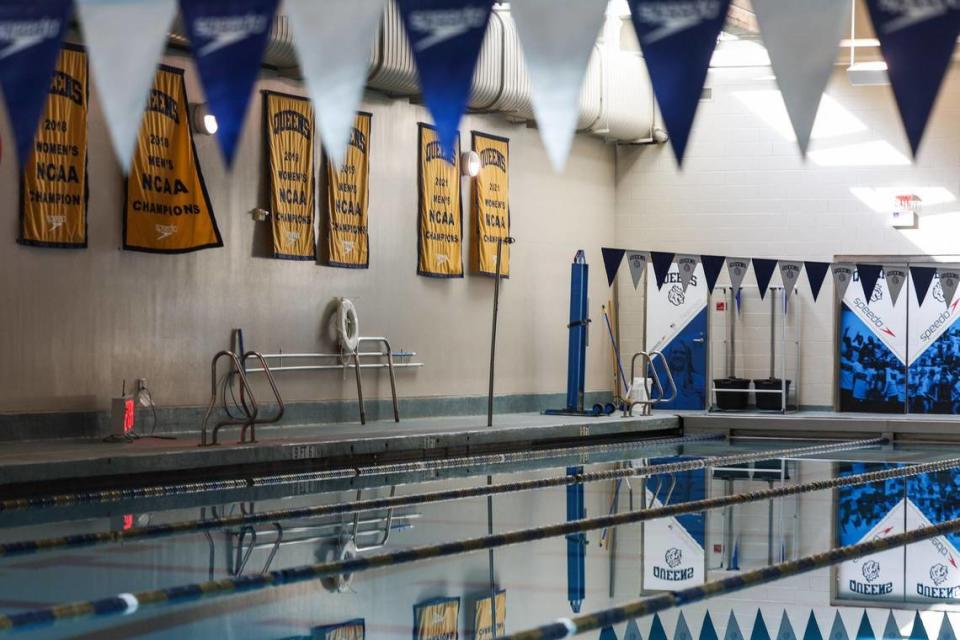Royals swim teams can’t win NCAA titles (for now). But there’s a grander plan, anyway.
Of the two dozen athletic teams at Queens University of Charlotte, the men’s and women’s swimming teams, it could easily be argued, had the most to lose by making the jump from Division II to Division I.
After all, both teams of Royals had won seven straight NCAA D-II national championships dating back to the 2015-16 season, and the transition would immediately spell the end of an era of dominance that was as impressive in Division II terms as the Boston Celtics’ Bill Russell-era dynasty.
But the teams built and led by head coach Jeff Dugdale also, potentially, had the most to gain from the move.
Or, at the very least, it was a chance to prove what many of those connected to the programs have believed for years: that Queens swimmers aren’t merely a force to be reckoned with at the D-II level, but capable of hanging with the best top-tier teams, too.
“We’ve always claimed we’ve been more of a D-I than a D-II,” says Dugdale, who also serves as an associate athletic director at the university. “So we recruited that way. That was because our focus was always on the Olympic Games. And if you had somebody that had the ability to make Olympic Games, we were gonna be better than everyone else.”
For those unfamiliar with Dugdale and Queens swimming, that might be a lot to take in.
So, to help you gain at least a little bit of a better understanding about what it all means — as well as how he and his teams got to where they are today and where they might be headed in the future — here’s a primer.

‘It would definitely be sad for me’
The reason why the transition from Division II to Division I meant Queens’ long streak of winning NCAA titles was over is simple: NCAA rules state that transitioning schools are not eligible to compete at NCAA championship events until achieving full membership in their new division. The transition takes four years.
And if you’re wondering how current and former Royals swimmers feel about giving up their national championship streak, not surprisingly, the emotions are mixed.
Some have concentrated on the bright side. With the teams’ foundation of success, “we can move to Division I and then really make history happen” at the new level, says Jan Delkeskamp, who is captain of the men’s swimming team.
But there’s also certainly some grieving going on.
“I feel like it must be a little bit sad,” says former Queens swimmer Vlada Maznytska, who was a part of five women’s NCAA championships before graduating last year (and whose younger sister Daryna is now a freshman on the team). “It would definitely be sad for me.”
Although Queens is temporarily ineligible for NCAA titles, it can vie for conference championships during the transition. Most of the school’s teams were new members of the ASUN Conference (formerly the Atlantic Sun Conference) this past year; but since the ASUN doesn’t sponsor swimming, the ASUN schools that do have swim teams all compete in the Coastal Collegiate Sports Association.
In February, the Queens men won the CCSA championship in commanding fashion. Their women’s team finished third.
Then in March, both squads sent large contingents to Indiana for the NIC — more formally known as the National Invitational Championship, a postseason meet that’s roughly the swimming equivalent of the NIT college basketball tournament and includes established Division I teams along with transitioning schools like Queens. The Royals men’s team won the NIC, beating big-name D-I programs like Tennessee and Ohio State, while the women placed 10th.
Why did the men do better than the women at both meets, after so many years of both winning D-II titles? One possible solution:
Per Title IX rules, the difference in the number of scholarships available for college men’s swim teams is 8.1 for Division II versus 9.9 for Division I. For women, the difference is 8.1 for D-II versus 14 for D-I. In other words, until just this past season, Queens’ women’s team couldn’t recruit nearly as many scholarship athletes as the best women’s swim teams in Division I.
And, all that said, Dugdale certainly can relate to what many connected to the program were feeling last year when the move to Division I was made.
“Yeah, there was disappointment,” he says. “People love winning, and we were winning a lot in D-II.”

Where did this guy come from, anyway?
Dugdale was a member of the men’s swim team at Auburn University from 1989 to 1991, then tapped by Tigers head coach David Marsh to join his staff in 1992.
Prior to Marsh, the swim teams at Auburn had posted losing records for three straight years. But when Auburn built its new pool, which opened in 1993, Marsh reserved a large wall in a prominent location to recognize Tiger swimmers who’d gone to the Olympics, Dugdale says — “and there were only three or four names on it.”
“I said, ‘Is that the right place for that?’ Because other than the (Olympic) rings, it was ugly,” Dugdale recalls. Basically, because it was so otherwise empty. “Coach Marsh goes, ‘No, it’s not ugly. It’s uncomfortable. So what do you think we have to do to make it comfortable?’ I said, ‘Ohhhhhh, I get it. You’re gonna give me a teaching lesson again.’ He goes, ‘Yes. We have to produce Olympians.’”
Marsh, in just his second year on the job when he hired Dugdale, would lead Auburn to 12 NCAA Division I titles — all of which Dugdale was a part of as an assistant. The school has since added dozens of names to that wall.
Then, after both had left Auburn, Dugdale and Marsh re-teamed in Charlotte in 2009 — Marsh, who gained fame leading SwimMAC Carolina’s Team Elite from 2007 to 2016, employed Dugdale as his “director of high performance.”
Queens tapped Dugdale to be its head coach in 2010, and he juggled both jobs for several years. In his time with Team Elite, he worked directly with Olympic swimmers including Ryan Lochte, Cullen Jones and Tyler Clary, before stepping down from that role in February 2016.
The following month, Dugdale led both the Royals men and women to the second straight NCAA Division II titles.

A focus on the Olympic Games
Despite the fact that their championship streak is over, there is a strong belief that the swimming teams’ winning ways will continue during and after the transition.
After Queens president Daniel Lugo explains, in general terms, “I expect sports that were competing for national championships at Division II to figure out how to do that in Division I,” he specifically singles out Dugdale’s squads. “I look at what Coach Dugdale’s done with swimming, and I think I’m most excited about the story that he is gonna build in being the smallest Division I school to get into the NCAA championship pool and score a lot of points.”
At the same time, Lugo is also realistic. “We’re probably not gonna win the Division I tournament. But it’s gonna shock people when he builds a top-10 program.”
The way to do that, of course, will be through recruiting. And according to Dugdale, his and his team’s efforts have continued to go swimmingly.
“My No. 1 recruit chose us over Southern Cal and Florida,” the coach says. Because “in their recruiting conversations, (the other schools) talked about the NCAA championships. I don’t have to worry about that. I talk about making the Olympic team. ... We’re an Olympians-made-here school. We are here to help you make the Olympic team.”
For example, Dugdale explains, “if for some reason it was not in your best interest to go to NCAAs that year because it would affect your Trials or how you would potentially make the team, we would have a difficult decision to make.”
In addition to the Olympians he helped coach with SwimMAC, since Dugdale took over at Queens in 2010, his program has produced three Olympians (Patricia Castro-Ortega, Dion Dreesen and Marius Kusch) and one (Hannah Aspden) who has won gold at the Paralympics.
He expects that list to grow. “Chances are — even if we were eligible for NCAAs — that we would prioritize the Olympic Games.”

